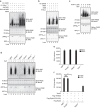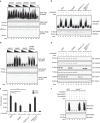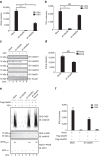Ube2D3 and Ube2N are essential for RIG-I-mediated MAVS aggregation in antiviral innate immunity
- PMID: 28469175
- PMCID: PMC5418627
- DOI: 10.1038/ncomms15138
Ube2D3 and Ube2N are essential for RIG-I-mediated MAVS aggregation in antiviral innate immunity
Abstract
Innate immunity plays a pivotal role in virus infection. RIG-I senses viral RNA and initiates an effective innate immune response for type I interferon production. To transduce RIG-I-mediated antiviral signalling, a mitochondrial protein MAVS forms prion-like aggregates to activate downstream kinases and transcription factors. However, the activation mechanism of RIG-I is incompletely understood. Here we identify two ubiquitin enzymes Ube2D3 and Ube2N through chromatographic purification as activators for RIG-I on virus infection. We show that together with ubiquitin ligase Riplet, Ube2D3 promotes covalent conjugation of polyubiquitin chains to RIG-I, while Ube2N preferentially facilitates production of unanchored polyubiquitin chains. In the presence of these polyubiquitin chains, RIG-I induces MAVS aggregation directly on the mitochondria. Our data thus reveal two essential polyubiquitin-mediated mechanisms underlying the activation of RIG-I and MAVS for triggering innate immune signalling in response to viral infection in cells.
Conflict of interest statement
The authors declare no competing financial interests.
Figures







Similar articles
-
MAVS-loaded unanchored Lys63-linked polyubiquitin chains activate the RIG-I-MAVS signaling cascade.Cell Mol Immunol. 2023 Oct;20(10):1186-1202. doi: 10.1038/s41423-023-01065-2. Epub 2023 Aug 15. Cell Mol Immunol. 2023. PMID: 37582970 Free PMC article.
-
Subcellular Localizations of RIG-I, TRIM25, and MAVS Complexes.J Virol. 2017 Jan 3;91(2):e01155-16. doi: 10.1128/JVI.01155-16. Print 2017 Jan 15. J Virol. 2017. PMID: 27807226 Free PMC article.
-
Dual targeting of RIG-I and MAVS by MARCH5 mitochondria ubiquitin ligase in innate immunity.Cell Signal. 2020 Mar;67:109520. doi: 10.1016/j.cellsig.2019.109520. Epub 2019 Dec 24. Cell Signal. 2020. PMID: 31881323
-
Recent Advances and Contradictions in the Study of the Individual Roles of Ubiquitin Ligases That Regulate RIG-I-Like Receptor-Mediated Antiviral Innate Immune Responses.Front Immunol. 2020 Jun 24;11:1296. doi: 10.3389/fimmu.2020.01296. eCollection 2020. Front Immunol. 2020. PMID: 32670286 Free PMC article. Review.
-
Regulation of antiviral innate immune signaling by stress-induced RNA granules.J Biochem. 2016 Mar;159(3):279-86. doi: 10.1093/jb/mvv122. Epub 2016 Jan 8. J Biochem. 2016. PMID: 26748340 Free PMC article. Review.
Cited by
-
Viruses utilize ubiquitination systems to escape TLR/RLR-mediated innate immunity.Front Immunol. 2022 Nov 25;13:1065211. doi: 10.3389/fimmu.2022.1065211. eCollection 2022. Front Immunol. 2022. PMID: 36505476 Free PMC article. Review.
-
Post-Translational Modifications of Proteins in Cytosolic Nucleic Acid Sensing Signaling Pathways.Front Immunol. 2022 Jun 20;13:898724. doi: 10.3389/fimmu.2022.898724. eCollection 2022. Front Immunol. 2022. PMID: 35795661 Free PMC article. Review.
-
High-Dose Vitamin B6 (Pyridoxine) Displays Strong Anti-Inflammatory Properties in Lipopolysaccharide-Stimulated Monocytes.Biomedicines. 2023 Sep 19;11(9):2578. doi: 10.3390/biomedicines11092578. Biomedicines. 2023. PMID: 37761018 Free PMC article.
-
Mouse adaptation of the H9N2 avian influenza virus causes the downregulation of genes related to innate immune responses and ubiquitin-mediated proteolysis in mice.Med Microbiol Immunol. 2020 Apr;209(2):151-161. doi: 10.1007/s00430-020-00656-4. Epub 2020 Jan 25. Med Microbiol Immunol. 2020. PMID: 31982962 Free PMC article.
-
The molecular mechanism of RIG-I activation and signaling.Immunol Rev. 2021 Nov;304(1):154-168. doi: 10.1111/imr.13022. Epub 2021 Sep 12. Immunol Rev. 2021. PMID: 34514601 Free PMC article. Review.
References
-
- Aoshi T., Koyama S., Kobiyama K., Akira S. & Ishii K. J. Innate and adaptive immune responses to viral infection and vaccination. Curr. Opin. Virol. 1, 226–232 (2011). - PubMed
-
- Stetson D. B. & Medzhitov R. Type I interferons in host defense. Immunity 25, 373–381 (2006). - PubMed
-
- Takeuchi O. & Akira S. Pattern recognition receptors and inflammation. Cell 140, 805–820 (2010). - PubMed
-
- Kato H. et al.. Differential roles of MDA5 and RIG-I helicases in the recognition of RNA viruses. Nature 441, 101–105 (2006). - PubMed
Publication types
MeSH terms
Substances
LinkOut - more resources
Full Text Sources
Other Literature Sources
Molecular Biology Databases
Miscellaneous

